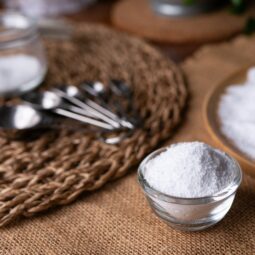
It’s not sugar. It’s not alcohol. So what is sugar alcohol?
Sugar alcohols are commonly used to make low-sugar or sugar-free foods taste sweet. Classified as carbohydrates, they are chemically altered sugar molecules that are not readily absorbed by the body. Some occur naturally in small amounts in certain fruits and vegetables, but most sugar alcohols are commercially produced from other starches and sugars.
On ingredients lists, you can identify sugar alcohols by looking for words that end in “tol,” such as erythritol, sorbitol and xylitol. You might find them in candies, ice cream, jams and other sweet-tasting products labelled as “diet,” “low calorie,” “reduced or low sugar,” “diabetes friendly,” “keto” or “no added sugar.”
They also show up in some sugar substitutes sold for home use. Many stevia products and monkfruit sweeteners, for example, also contain erythritol, which is added to balance out the sweetness and improve the aftertaste.
How are sugar alcohols different?
Compared to other sweeteners, sugar alcohols offer differences in sweetness, calories and other qualities. Here’s a quick look:
Sugar alcohols vs. table sugar/sucrose
- Fewer calories: Sugar alcohols range from 0.2 to 3 calories per gram, while sugar provides 4 calories per gram.
- Similar sweetness: Sugar alcohols range from 25% to 100% as sweet as sugar.
- Lower blood glucose impact: Sugar alcohols affect blood glucose levels less than sugar.
- Less tooth decay: Sugar alcohols aren’t metabolized by the bacteria in the mouth, so they don’t promote tooth decay the way sugar does.
Sugar alcohols vs. other artificial sweeteners
- More calories: While sugar alcohols do provide some calories, other artificial sweeteners (e.g., aspartame, saccharin, acesulfame potassium, sucralose and neotame) are calorie free.
- Less sweetness: Sugar alcohols are far less sweet than other artificial sweeteners, which can be so sweet — 200 to 700 times sweeter than table sugar — that they overstimulate the taste buds and make naturally sweetened foods taste bland and less appetizing.
- Slightly higher blood glucose impact: While sugar alcohols have a low impact on blood glucose, other artificial sweeteners are lower still, with minimal to zero direct impact.
- Less aftertaste: Sugar alcohols taste more like sugar, with no aftertaste, while other artificial sweeteners tend to leave an aftertaste.
Weighing the upsides and downsides
Sugar alcohols, like all added sweeteners, have their upsides and their downsides.
The upsides can best be expressed in terms of what they don’t do:
- Sugar alcohols don’t lead to big spikes in blood sugar, since your body absorbs them more slowly than sugar and can’t fully digest them.
- They don’t increase the risk of tooth decay, as sugar does.
On the downside:
- Sugar alcohols can cause persistent diarrhea in some people, so limiting or avoiding them is especially important for people with bowel issues (packages list ingredients in descending order by amount, so make sure “–tol” ingredients are near the bottom of the list).
- Like other artificial sweeteners, they may lead to less healthy choices between lower-calorie/highly processed desserts and naturally sweetened/more nutritious options.
- While the research is not definitive, some studies suggests that artificial sweeteners can activate reward pathways in the brain that increase appetite and hunger signals.
The bottom line: Products labeled as “sugar free” or “low sugar” offer some benefits, but they’re not necessarily healthier by default. And although they’re lower in sugar, they still can have a significant number of calories and carbohydrates, so you need to continue to be mindful when choosing them as part of a weight-loss effort. Whether choosing sugar, sugar alcohols or other sweeteners, our mantra remains the same: Moderation is key.


